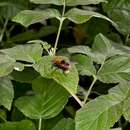fi
nimet breadcrumb-navigoinnissa


Mesembrina mystacea is a fly belonging to the family Muscidae.
This species is present in the Palaearctic realm, from Fennoscandia south to Turkey and from the Atlantic seaboard across Eurasia to as far as Mongolia. [1][2][3][4]
Mesembrina mystacea can reach a length of 9–12 millimetres (0.35–0.47 in). These large, distinctive flies are beautifully colored in black, yellow-brown and white. They have a stout body. The long body hairs are mostly black, but they show a band of fine yellow-brown short hairs anteriorly across the thoracic dorsum and dense brown hairs on the abdomen, with white hairs at the edge. Metathorax and abdomen are shiny black. Eyes are bare. A large orange colouration is present on the base of the wings.[1]
The species exhibits a certain sexual dimorphism. In fact the anterior yellow-brown thoracic band of hairs is much narrower in the male than in the female. Moreover in the male the mid tibiae are curved with longer hairs, while in the females they are straight and without longe hairs. [1]
These flies closely mimic certain Bombus species (bumblebees) (Apidae family). They are very similar to the hoverflies Criorhina berberina and Pocota personata (Syrphidae). Superficially they also resemble the hoverfly Volucella bombylans. M. mystacea is the only bumble-bee mimic among the Mesembrina species present in western Europe.[1][5]
Adults of Mesembrina mystacea can be found from June to September. The larvae feed on dung and dead material. In western Europe these flies are forest insects. They can be found in woodland or be grazed by cattle, in the Quercus, Fagus and Picea zones.[1] This species belongs to insects with complete metamorphosis which involves a pupal stage. [6]
Mesembrina mystacea is a fly belonging to the family Muscidae.
Mesembrina mystacea adolah langau dari famili Muscidae. Langau iko juo marupokan bagian dari ordo Diptera, kelas Insecta, filum Arthropoda, dan kingdom Animalia.
Lambrecht (1980: 369) mampakiroan bahwa famili Muscidae barasal dari maso Perm, walaupun alun ditamuan fosil nan labiah tuo dari maso Eosen.
Mesembrina mystacea adolah langau dari famili Muscidae. Langau iko juo marupokan bagian dari ordo Diptera, kelas Insecta, filum Arthropoda, dan kingdom Animalia.
Mesembrina mystacea is een vliegensoort uit de familie van de echte vliegen (Muscidae).[1] De wetenschappelijke naam van de soort is voor het eerst geldig gepubliceerd in 1758 door Linnaeus.
Bronnen, noten en/of referenties
Mesembrina mystacea er en stor, tett hårete, hunlelignende flue som er vanlig i fjellbjørkeskogen. Den tilhører møkkfluene (Muscidae), en artsrik familie av fluer.
Det er flere ytre kjennetegn som skiller familiegruppen møkkfluer fra andre nærstående fluer. For en generell beskrivelse se hovedsiden om møkkfluer.
Mesembrina mystacea etterligner humler og ligner overfladisk på humleblomsterfluen (Volucella bombylans) i familien blomsterfluer. Den er vakkert farget i svart, gul og hvit pels.
Mesembrina mystacea hører til møkkfluene, en gruppe som både kan være plagsomme og smittespredere, men regnes ikke å være blant de skadelige.
Larvene lever av dødt materiale (saprofager), og bidrar til nedbrytingen og dermed til stoffkretsløpet.
Mesembrina mystacea tilhører gruppen av insekter med fullstendig forvandling (holometabole insekter), som gjennomgår en metamorfose i løpet av utviklingen. Mellom larvestadiet og det voksne stadiet er et puppestadie, en hvileperiode, der fluens indre og ytre organer endres. Helt mot slutten av puppestadiet blåser fluen opp en «ballong», bak spalteåpning kalt frontalsuturen. Dette er nødvendig eller i alle fall til god hjelp, for å komme seg ut av puppehylsteret. Utviklingstiden eller generasjonstiden er avhengig av temperaturen.
Mesembrina mystacea er en stor, tett hårete, hunlelignende flue som er vanlig i fjellbjørkeskogen. Den tilhører møkkfluene (Muscidae), en artsrik familie av fluer.